

Control accuracy of tension system is an important index in roll-to-roll gravure printing machines. However, the complex relationships of the tension system make the problem of coupling model difficult to be solved, which has limited the improvement of tension control accuracy. Therefore, a coupling mechanism model of global tension system is established and analyzed for the gravure printing machines in this study. According to the working principles and assumptions, tension model of the two-roller system is derived by considering the effects of drying temperature, and then the tension models of subsystem including unwinding subsystem, printing subsystem and rewinding subsystem are established. Based on these, the global coupling mechanism model of the tension system is established for roll-to-roll gravure printing machines. Finally, the coupling model is analyzed by MATLAB simulation, and the simulation results show that the tension system model established in this paper can accurately reflect the characteristics of tension system.
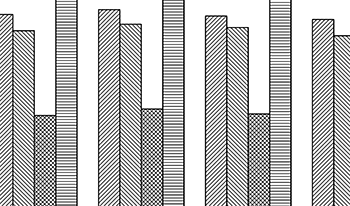
The purpose of this paper is to study the influence of different adhesives and dosage on the performance of ink absorption coating and improve the quality of foam surface. In this experiment, silica was used as pigment, PVA1788, PVA1799, PVA235 and soluble starch were used as binders, and rigid polyurethane foam was used as coating object. In this experiment, a spraying method was used to coat the surface of plastic foam, UV printer was used for graphic output, and related equipment were used to test the performance of the coating. The results showed that when the ratio of adhesive (PVA1788) to pigment was 20%, the whiteness and wettability of the coating were the best. In this case, rich color range and gradation level could be obtained. With the increase of the alcoholysis of polyvinyl alcohol, the dissolution became difficult, water resistance increased, bonding force increased, film formation became better, and the contact angle of the coating prepared by the high alcoholysis of PVA as adhesive was lower. The coating with PVA235 as adhesive had the highest color density and the best comprehensive effect.
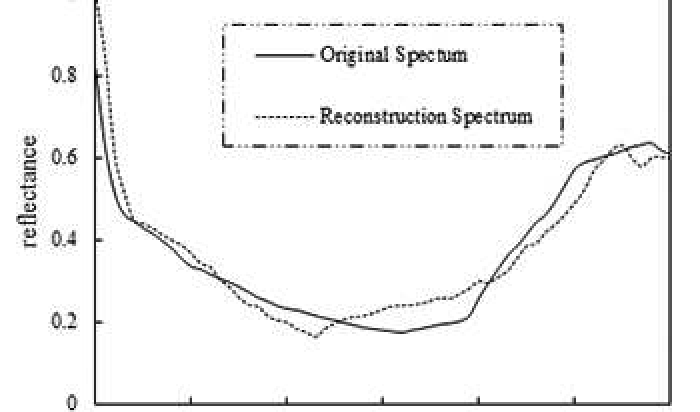
Spectral reflectance reconstruction is the key technology of multi-spectral color reproduction, and it solves the exact color information restoring of original scene to provide color information support for high-fidelity reproduction. The current mainstream principal component analysis method is suitable for information reconstruction of simple objects and smooth objects, and the independent component analysis method is adaptive for color main component extraction of complex objects or scenes. Integrating the advantages of these two methods and imported blind source signal estimation theory, this study highlights the adaptive component analysis method for spectral reflectance reconstruction. Firstly it clarified the reconstruction principle and method of adaptive component analysis methods, and then it carried on the spectral reflectance reconstruction test by selecting the typical color lumps of Finland University “AOTF Munsell Color Matt” spectrum dataset. The results showed the reconstruction precision was higher and the spectral matching skewness index was very small (less than 0.020 basic), besides the reconstruction efficiency was higher and the method adaptability was stronger. Moreover, this study provided a new theoretical interpretation for Color Constancy Theory of human vision.

Polyacrylate latexes made from non-polymerizable emulsifiers and their inks typically suffer from poor ethanol resistance stability and low adhesion on biaxially oriented polypropylene (BOPP) and polyethylene (PE) films. In this contribution, a composite emulsifier system containing a polymerizable anionic and a polymerizable non-ionic emulsifier was used to synthesize core-shell polyacrylate latexes. Additionally, a control latex was also prepared using a traditional emulsifier TX-30 to replace the polymerizable non-ionice mulsifier in the above composite emulsifiers. The effect of the polymerizable emulsifier on ethanol resistance, Ca2+ resistance stability, and adhesion on PE and BOPP films of the latexes and the inks, and water resistance of the latex films and ink films were studied. The results show that, when compared with the control latex, the one made from double polymerizable compound emulsifier system and its ink demonstrates better ethanol resistance, higher stability of calcium ions and higher adhesion on BOPP and PE. When the ratio of anionic emulsifier to non-ionic emulsifier is 1.5/1 and the total dosage is 2.5 wt%, the latex showed the best comprehensive performance. The calcium ion resistance stability of the latex increased from 5% of the control latex to 25%. Accordingly, the adhesion of yellow ink on BOPP film increased from 92% of the ink based on the control latex to 99% and increased from 99% to 100% on PE film. The adhesion of blue ink on BOPP film increased from 92% to 99%, and from 99% to 100% on PE film. These results indicate that the fully polymerizable emulsifiers can effectively improve the properties of latex.

The purpose of the study is to prepare reversible thermochromic materials with good discoloration properties, which are used as fillers to prepare a new type of reversible thermochromic ink. Reversible thermochromic materials were prepared by solid phase method with crystal violet lactone as chromogenic agent, boric acid as chromogenic agent and hexadecanol as cosolvent, and reversible thermochromic ink was prepared by using thermochromic material as filler. The scanning electron microscope images of reversible thermochromic materials showed that the prepared materials were spherical and had the advantages of non-adhesion. The printability of reversible thermochromic ink was discussed by changing the parameters including content of thermochromic material, printing pressure, ink sequence and using printability tester. The test of color change performance of thermochromic ink showed that the color change temperature range was 47.5–51.1∘C, the color change time was 46 s, the recolor time was 29 s, and the stability was excellent. The reversible thermochromic ink has a certain application value in anti-counterfeiting printing.
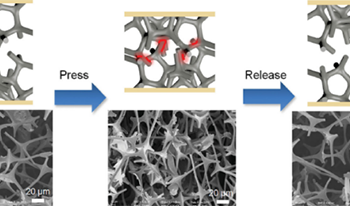
Printable flexible pressure sensors have many important applications in wearable systems. One major challenge of such a sensor is to maintain sensing properties in high temperature. By optimizing the curing mechanism of the flexible pressure sensor functional materials, this paper proposes a new method of achieving high temperature properties for a full printed sensor. The establishment of curing theory is mainly studied. The printing process of this kind of sensor is systematically stated and tested to check whether it can continue to function at high temperatures. Ultimately a fully-printed flexible pressure sensor with good temperature performance is achieved. The paper focuses around the technical route of “material selection—theoretical analysis—function material preparation—design and preparation of device—device performance evaluation”. Suitable materials are used in flexible pressure sensors and the curing mechanism is established. This proposed technique can be extended to the development of other printable flexible sensors, which can lead to a huge impact on future applications of the flexible electronics.
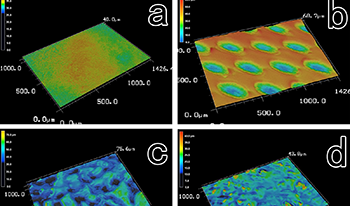
Printed electronics is an emerging technology that applies traditional printing or coating processes to the manufacture of electronic devices and products. In order to find a low-cost, high-performance, environmentally-friendly flexible substrate suitable for electronic devices, the printability between four kinds of inkjet photo papers and nano-silver ink was investigated. First, different surface morphologies of the inkjet photo papers were measured by a confocal laser scanning microscopy. Then, a pen and a gravure printer were used to test the printability between photo papers and nano-silver ink. It was found that the conductive track and pattern was influenced by the surface morphology of the photo papers. Furthermore, a four-probe test showed that the conductivity of the ink layers on the four photo papers was almost at the same level. Furthermore, a tearing test with 3 M tapes showed that the silk photo paper had the best tearing resistance. In general, silk photo paper has the best overall performance. This research could be beneficial for the development of flexible electronic devices which are low-cost, mass manufacture suitable and environment friendly.

A kind of waterborne varnish for inkjet printing was synthesized, and properties of the waterborne varnish were characterized to make it suitable for the glazing requirements of inkjet printing and other printability requirements. The waterborne varnish was synthesized from epoxy resin (E-51), epoxy diluent (ED), acrylic acid, trimellitic anhydride, maleic anhydride and organic amine by three steps of ring opening reaction, esterification reaction, neutralization reaction. The viscosity, film-forming property, water absorption of waterborne varnish and the water resistance, lightness, wear resistance and bonding strength of coated paper were tested. The effects of the ratio of E-51 and ED in the polymerization system on the properties of waterborne varnish were studied. In the test of printability of self-made waterborne varnish, the absorption of digital inkjet paper to varnish and the influence of varnish on color reproduction of printed image were discussed and studied. The results show that when the molar ratio of epoxy group in E-51 and ED is about 1:1, the prepared varnish is suitable for inkjet printing, and its film-forming property, such as water resistance, adhesion and friction resistance are better. At the same time, its printability is also better.
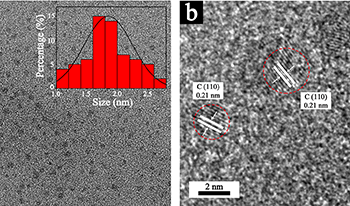
Carbon dots (CDs) with excellent fluorescent performance are a potential material to restrain fakes, but the complex processes, high cost, and toxicity impede their application. Here, Lycium ruthenicum is employed as the carbon source, and eco-friendly CDs are obtained via a one-step hydrothermal method. The reaction conditions such as dosage, temperature, and time are optimized to achieve high yield, and the morphology, surface functional groups, and optical properties are characterized by scientific instruments. The results show that the spherical CDs with a diameter of 1.83 ± 0.30 nm have excellent solubility and a strong absorption peak at 285 nm. Subsequently, CDs were made into fluorescent inks; an ink-jet printer and a fountain pen are selected to examine the anti-counterfeit effect. Notably, the encrypted patterns can be hidden and perceived easily under natural light and UV light. Hence, these prepared CDs are expected to be an alternative material to be applied in the security field.